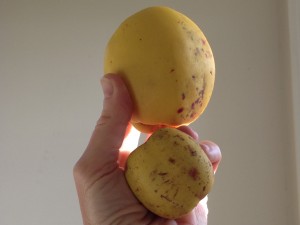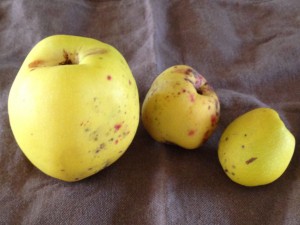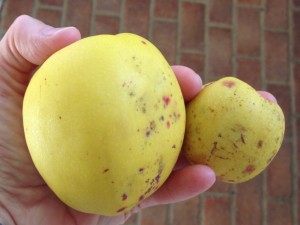Mighty quince. Sacred to Aphrodite, supposedly it sprung up wherever she stepped as she was born from the foaming sea. And legend has that Paris awarded it to her as first prize in a beauty contest, igniting the Trojan War. It was for a quince that Atalanta stopped during her famous race. Many believe the infamous apple offered to Adam by Eve was in fact a quince.
In the Rosaceae family along with apples and pears, quince is the only member of the genus Cydonia. Its fragrance is florally exquisite, likened by one fruit expert to a combination of pineappple, guava, and pear. Not a stretch to see why it is associated with fertility, love and life.
It is inedible raw, however, and not easy to work with– its flesh is hard, its skin slightly fuzzy, but also greasy. Perhaps this is a metaphor for the challenges of life– it takes patience and manual labor to get to the good stuff– and why this fruit is largely unknown in the US.
I fell in love with quince when the first house I rented in the Hudson Valley happened to have a pair (no pun) out front. We moved in very early spring; by May they were in full bloom. It looked like some kind of fruit tree, but I did not pay much attention. Then the fruit developed.
Suddenly there was this amazing perfume as I walked out to the car in the morning. Where was it coming from?! This fuzzy yellow fruit, the size of apples but less regular in shape and harder. It blew me away.
I knew quince from membrillo, the Spanish quince paste so umami with Manchego and Serrano. But I also remembered it from my son’s pediatrician in Paris, who recommended gelée de coings when as a toddler Christophe had some early summer diarrhea. The high pectin content, it seems, acts as a natural binder.
That high pectin means no additional is needed when preserving. In the past I’ve made a preserve by peeling and coring the fruit, then chopping the slightly unmanageable flesh into large dice and cooking with sugar and lemon juice. Delicious.
But it seems a bit wasteful, not to mention labor intensive– the peeling alone is pretty tough. So this year I am attempting a sort of cross between preserve and paste, by cooking the fruit with skin, seeds and all, milling it then cooking again with sugar…we’ll see.
Meanwhile as mentioned previously my own quince bush bore fruit this year, the first I’ve seen. I thought there were maybe a dozen or so fruit to be harvested, but after the leaves came down some that had been hiding became apparent. There ended up being nearly 10 pounds of fruit. While most is smaller, like small kiwi, a few were larger, and one, tucked in at the middle of the bush, was a real beauty and as big as a good sized apple.
I felt like I’d found the prize in the cereal box and it was a good one.

